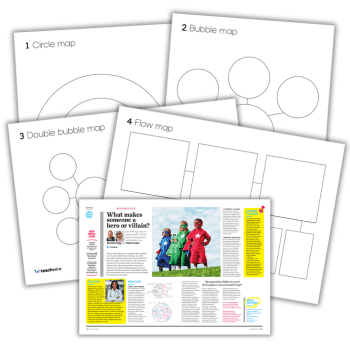Teaching assistant training – Don’t rely on friendships between TAs and teachers

A good TA is worth their weight in gold, but we shouldn’t rely on goodwill between TAs and teachers to make the role a success…

- by Sara Alston
- SENCo, author and SEND consultant with 35 years of experience Visit website

A universally acknowledged truth of primary teaching is that a good TA is worth their weight in gold.
Yet this doesn’t tell the whole story, because what makes an outstanding TA is more complex than their innate good qualities. The role of the TA developed gradually from parent helpers and ancillary staff who largely supported with practical tasks, to today’s ‘paraprofessionals’ who often lead whole-class learning.
This organic growth means that the role has developed in different ways in different places, with no standardisation in approach to the expectations of TAs, or the teachers working with them. This is exacerbated by a lack of training for either TAs or teachers on how to work together.
The DISS (2009) and MITA (2015) projects identified three key difficulties with TA effectiveness, related to their preparedness, deployment and practice. This meant that although TAs were highly valued by teachers, they had little positive, and often a negative, impact on children’s learning.
The research placed the responsibility for this with school leaders. However, the effectiveness of many TAs’ practice is dependent on their relationship with the classroom teacher.
Last December I asked teachers and TAs on Twitter about their working relationships. Several key themes emerged. Most confirmed the view that a good TA acts as ‘a safety net, sounding board and sanity saver’, though the underlying difficulties of making this relationship work to support children’s learning, rather than just the teacher, were highlighted.
The Teaching Assistant role
Many respondents spoke about the importance of partnership and friendship. TAs want teachers to share the load, so they can support them. At the same time, they want to be treated as equals and not as a dogsbody or slave. Both teachers and TAs spoke of friendships established in the classroom that have lasted over many years. The teacher and TA working relationship was also described to me as learning to dance. You have to learn to complement each other. Sometimes it’s a polished American smooth; other times it’s freestyle. It’s a partnership with common goals and if that’s not in place, it becomes hard work for both parties, with toes regularly stood on.
One TA summed up the issues of sharing planning, saying, “We didn’t plan it. It’s not as obvious to us!” This was a recurring theme. As the MITA and DISS projects identified, a lack of preparedness impacts the effectiveness of TAs’ work. For a TA to follow planning, they need to be able to see, share and understand it.
However, few are given time to read it in advance, and some do not see it at all.
Teachers often complained that TAs arrived with the children, so accessed the lessons alongside them and were then expected to respond and differentiate without preparation. This isn’t an effective way to work. Time to share planning often depended on a willingness to find time outside of the TA’s directed hours.
This was often rooted in friendship, not time identified by the school.
Teaching Assistant skills
Many respondents spoke of the importance of TAs feeling valued and respected. This included teachers asking TAs’ opinions, giving them feedback and listening to their views. Where teachers fail to acknowledge and understand TAs’ roles – recognising when they give time beyond their hours, rather than just expecting it, for example – there is a reduction in cooperation and engagement.
Both TAs and teachers spoke of the importance of TAs using their initiative and being given opportunities to do so. In a successful relationship, TAs are able to play to their strengths, often taking responsibility for particular areas.
This allows teachers time to observe and work with individuals, while enabling TAs to develop their skills and feel valued. Several TAs spoke of their frustration at watching a teacher deliver badly something they felt that they could do better.
Equally, teachers spoke of their exasperation at TAs ‘taking over’ and even spoiling their lessons when they offered views or engaged inappropriately.
Both TAs and teachers are concerned about where the responsibility for the planning and delivery of differentiation lies. This is interlinked with the recurring issue of finding time to share planning, give feedback and develop understanding of individual children and their needs. This, in turn, reduces the impact and effectiveness of differentiation.
Some TAs feel isolated working one-to-one, particularly with a high needs child. They feel responsibility for the child’s education and that making the curriculum accessible has been devolved to them. Many do not feel confident, equipped, or supported to do this, and say that the teachers don’t know or engage with these children.
Equally, several TAs commented that they spend longer with the children, so know them and their motivations better than the teachers. They want this expertise to be acknowledged and to share it with teachers.
However, several teachers referred to TAs ‘taking over’ and ‘dominating’ children; making it difficult for the teacher to work with and get to know those pupils. There is a significant tension around effective support for children with special needs.
Teaching Assistant jobs
Several issues were raised concerning age gaps between teachers and TAs. Many saw this as an advantage: younger TAs can help teachers to understand children’s interests and concerns. However, several NQTs and younger teachers spoke of their difficulties around directing older and more experienced TAs.
Several TAs also spoke of the impact of a lack of job security and being moved around the school, often at short notice. This means that they are constantly trying to re-negotiate their relationships with children and teachers. This reduces their effectiveness, willingness and commitment to engage in the school.
Both teachers and TAs voiced concerns about TAs being used as cheap cover. In particular, TAs are sometimes held to the same standards as teachers, but without the training or time to prepare the lessons they are expected to deliver.
Further, TAs often have a lower level of support when delivering lessons – they can’t support themselves and are not replaced when they become the primary deliverer of teaching.
How TAs can make an impact
The issues surrounding time to communicate and build relationships threaded through almost every response. The lack of time and breakdown of relationships are the biggest barriers to TAs and teachers working together successfully. As one respondent put it, “The key is clarity of communication and mutual trust.”
For TAs to have a positive impact, the issues of preparedness, deployment and practice have to be circumvented by good personal relationships between teacher and TA. This then supports communication and creates a willingness and ability to make time for it.
However, we shouldn’t expect this to be the underlying basis for the provision of effective support in the classroom. As one respondent commented, being a TA is “low paid, so the job needs to be rewarding in other ways.” A good relationship is one way, but it’s not enough.
TAs need time, respect and training, and teachers need help and support to utilise TAs effectively. We shouldn’t depend on friendships to make this key classroom relationship work to support learning.
Sara Alston is an independent consultant, trainer and practising SENCo. Her new book, co-authored with Daniel Sobel, is called The Inclusive Classroom: A New Approach to Differentiation (Bloomsbury). Follow her on Twitter at @seainclusion. Visit her website here.










